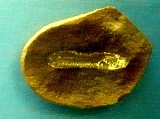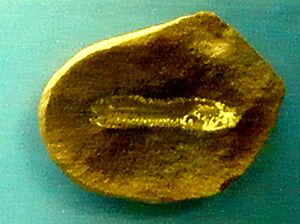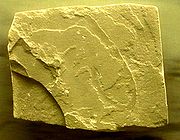
List of prehistoric annelids
Encyclopedia

Genus
In biology, a genus is a low-level taxonomic rank used in the biological classification of living and fossil organisms, which is an example of definition by genus and differentia...
that have ever been included in Annelida which have been found preserved as fossils. This list excludes purely vernacular terms. It includes all commonly accepted genera, but also genera that are now considered invalid, doubtful (nomina dubia
Nomen dubium
In zoological nomenclature, a nomen dubium is a scientific name that is of unknown or doubtful application...
), or were not formally published (nomina nuda
Nomen nudum
The phrase nomen nudum is a Latin term, meaning "naked name", used in taxonomy...
), as well as junior synonyms of more established names, and genera that are no longer considered acanthodians.
Naming conventions and terminology
Naming conventions and terminology follow the International Code of Zoological NomenclatureInternational Code of Zoological Nomenclature
The International Code of Zoological Nomenclature is a widely accepted convention in zoology that rules the formal scientific naming of organisms treated as animals...
. Technical terms used include:
- Junior synonym: A name which describes the same taxon as a previously published name. If two or more genera are formally designated and the type specimens are later assigned to the same genus, the first to be published (in chronological order) is the senior synonym, and all other instances are junior synonyms. Senior synonyms are generally used, except by special decision of the ICZN, but junior synonyms cannot be used again, even if deprecated. Junior synonymy is often subjective, unless the genera described were both based on the same type specimen.
- Nomen nudumNomen nudumThe phrase nomen nudum is a Latin term, meaning "naked name", used in taxonomy...
(Latin for "naked name"): A name that has appeared in print but has not yet been formally published by the standards of the ICZN. Nomina nuda (the plural form) are invalid, and are therefore not italicized as a proper generic name would be. If the name is later formally published, that name is no longer a nomen nudum and will be italicized on this list. Often, the formally published name will differ from any nomina nuda that describe the same specimen. - Nomen oblitumNomen oblitumA nomen oblitum is a technical term, used in zoological nomenclature, for a particular kind of disused scientific name....
(Latin for "forgotten name"): A name that has not been used in the scientific community for more than fifty years after its original proposal. - Preoccupied name: A name that is formally published, but which has already been used for another taxon. This second use is invalid (as are all subsequent uses) and the name must be replaced. As preoccupied names are not valid generic names, they will also go unitalicized on this list.
- Nomen dubiumNomen dubiumIn zoological nomenclature, a nomen dubium is a scientific name that is of unknown or doubtful application...
(Latin for "dubious name"): A name describing a fossil with no unique diagnostic features. As this can be an extremely subjective and controversial designation, this term is not used on this list.
| : |
|---|
A
- Aglaurides
- Albertaprion
- Amphictene
- Anisocerasites
- Arabella
- Arabellites
- Archaeoprion
- Archarenicola
- Arenicola
- Arites
- Asterosalpinx
- Astreptoscolex
B
- Biconulites
- Bipygmaeus
- Bohemoscolex
- Brochosogenys
- Bundenbachochaeta
- BurgessochaetaBurgessochaetaBurgessochaeta is an extinct genus of polychaete annelid from the Middle Cambrian. Its fossils have been found in the Burgess Shale in British Columbia, Canada.- Sources :...
C
- Camptosalpinx
- Campylites
- CanadiaCanadia (genus)Canadia is a genus of extinct annelid worm present in Burgess Shale type Konservat-Lagerstätte. It is found in strata dating back to the Delamaran stage of the Middle Cambrian around 505 million years ago, during the time of the Cambrian explosion. It was about 3 centimeters in length...
- Carbosesostris
- Cementula
- ChaetosalpinxChaetosalpinxChaetosalpinx is an ichnogenus of bioclaustrations . Chaetosalpinx includes straight to sinous cavities that are parallel to the host’s axis of growth. The cavity is circular to oval in cross-section and it lacks a wall lining or floor-like tabulae...
- Circeis
- Clavulites
- Conora
- Cowiella
- Crininicaminus
- Cryptosiphon
- Ctenoscolex
- Cubiculovinea
- Cycloserpula
D
- Delosites
- Didontogaster
- Dinoscolites
- Diopatraites
- Diploconcha
- Discouvermetulus
- Ditrupa
- Ditrupula
- Dodecaceria
- Dorvillea
- Drilonereis
- Dryptoscolex
E
- Ebetallites
- Elleriprion
- Eopolychaetus
- Eotomopteris
- Eotrophonia
- Epitrachys
- Esconites
- Eunice
- Eunicites
- Euryprion
F
- Falkosites
- Fastuoscolex
- Filograna
- Filogranula
- flabelligerid
- Flucticularia
- Fossundecima
G
- GaleolariaGaleolariaGaleolaria is a genus of tube-building annelid fanworms in the family Serpulidae. -Form:Galeolaria, is first observed by the limy tubes within which the worm lives...
- Gammascolex
- GeniculariaGeniculariaIn taxonomy, Genicularia is a genus of algae, specifically of the Gonatozygaceae.-Scientific databases:...
- Gitonia
- Glycera
- GlyceritesGlyceritesA glycerite is a fluid extract of an herb or other medicinal substance made using glycerin as being integral to the fluid extraction medium.According to King's American Dispensatory , glycerite is:Glycerita.—Glycerites....
- Goniada
- Gotlandites
H
- Hadimopanella
- Hadoprion
- Haileyia
- Halla
- Hammatopsis
- Hamulus
- Hesionites
- Hicetes
- Hindenites
- Hindeoprion
- Hirudopsis
- Homaphrodites
- Houscolex
- Howellitubus
- HydroidesHydroidesHydroides is a genus of tube-forming serpulid worm found on submerged saltwater rocks, shells, and boats in many coastal areas around the world.- Species :It contains the following species:* Hydroides bispinosa...
- Hystriciola
I
- Ildraites
- Insulicorypha
- Iquitosia
J
- Janita
- Jereminella
- Josephella
K
- Kaimenella
- Kalloprion
- Kettnerites
- Khemisina
- Klakesia
L
- Lanceolatites
- Langeites
- Laqueoserpula
- Lecathylus
- Lepidenteron
- Lercaritubus
- Levisettius
- Lockportia
- Longitubus
- Lumbriconereis
- Lumbricopsis
- Lysaretides
M
- Maeandropolydora
- Marlenites
- Marphysaites
- Melanoraphia
- Mercierella
- Meringosoma
- Metalaeospira
- Metavermilia
- Microdactylophora
- Microtubus
- Milaculum
- Mochtyella
- Multiprion
- Muroserpula
- Myzostomites

N
- Nawnites
- Neodexiospira
- Neomicrorbis
- Neovermilia
- Nereidavus
- Nothrites
- Notocirrus
O
- Oblongiprion
- Oenonites
- Oliveirania
- Onuphis
- Ophryotrocha
- Ornatoporta
- Orthoconorca
- Orthopelta
- Ottawella
- Ottawina
- Oxyprion
P
- Palaeoaphrodite
- Palaeochaeta
- Palaeodactylophora
- Palaeopelyx
- Palaeoscolecida
- Palaeoscolex
- Paleonereites
- Paleononites
- Paliurus
- Palurites
- Paradrilonereigenys
- Paraglycerites
- Paragnathites
- Paralaeospira
- Paranereites
- Paraterebella
- Parsimonia
- PectinariaPectinaria (worm)Pectinaria is a genus of sand tube-building annelid fanworms in the family Pectinariidae.-Species:* Pectinaria articulata* Pectinaria australis Ehlers, 1904* Pectinaria belgica * Pectinaria californiensis...
- Pegmaticula
- Pentaditrupa
- Pernerites
- Peronochaeta
- Phiops
- Phragmosalpinx
- Pieckonia
- Pileolaria
- Pistoprion
- Placostegus
- Plasmuscolex
- Polychaetaspis
- Polydora
- Pomatoceros
- Pontobdellopsis
- Praeglycera
- Praelumbrinereis
- Processoprion
- Pronereites
- Propolynoe
- Propomatoceros
- Protarabellites
- Protectoconorca
- Proterebella
- Proterula
- Protonympha
- Protoscolex
- Protula
- Protulites
- Protulophila
- Psammosiphon
- Pteropelta
- Pyrgopolon
R
- RamessesRamessesRamesses is the name conventionally given in English transliteration to 11 Egyptian pharaohs of the later New Kingdom period. The name essentially translates as "Born of the sun-god Ra"....
- Ramphoprion
- Raphidiophorus
- Rhamphegenys
- Rhytiprion
- Rotularia
- Ruedemannella
- Rutellifrons
S
- SabellariaSabellariaSabellaria is a genus of marine polychaete worms in the family Sabellariidae. The type species is Sabellaria alveolata . These worms are sedentary and build tubes in which to live from sand and shell fragments. Some species are called honeycomb worms and when they occur in great numbers they can...
- Salmacina
- Sarcinella
- Sarcionata
- Schistomeringos
- Schizoproboscina
- Sciotoprion
- Sclerostyla
- Scolecoderma
- Semiserpula
- Serpentula
- SerpulaSerpulaSerpula is a genus of sessile, marine annelid tube worms that belongs to the Serpulidae family...
- Serpularia
- Serpulopsis
- SerratulaSerratulaSerratula is a genus of at least 17 species in the daisy family native to the old world. Serratula as traditionally defined contains at least two groups: one of which is basal within the subtribe Centaureinae and one of which is derived; the former group can be moved to the genus Klasea.Various...
- Sinuocornu
- Siphonostomites
- Skalenoprion
- Soris
- Spiraserpula
- Spirographites
- SpirorbisSpirorbisSpirorbis is a genus of very small polychaete worms, usually with a white coiled shell. Members of the genus live in the lower littoral and sublittoral zones of rocky shores. Spirorbis worms usually live attached to seaweeds, but some species live directly on rocks, shells or other hard substrates...
- Staurocephalites
- Stauronereisites
- StephenoscolexStephenoscolexStephenoscolex is a genus of polychaete worm known from the Middle Cambrian Burgess Shale....
- Sthenelaites
- StomaStomaIn botany, a stoma is a pore, found in the leaf and stem epidermis that is used forgas exchange. The pore is bordered by a pair of specialized parenchyma cells known as guard cells that are responsible for regulating the size of the opening...
- Streblosoma
- Streptindytes
- Symmetroprion
T
- Terebella
- Terebellites
- Terebellolites
- Tetraprion
- Tetraserpula
- Thalenessites
- Titahia
- Torlessia
- Tosalorbis
- Trentonia
- Triadonereis
- Trianguligenys
- Tubulelloides
- TurbiniaTurbiniaTurbinia was the first steam turbine-powered steamship. Built as an experimental vessel in 1894, and easily the fastest ship in the world at that time, Turbinia was demonstrated dramatically at the Spithead Navy Review in 1897 and set the standard for the next generation of steamships, the...
U
- Uncinogenys
- UngulitesUngulitesUngulites is an extinct genus of prehistoric nautiloid. The nautiloids are a subclass of shelled cephalopods that were once diverse and numerous but are now represented by only a handful of species.-References:...
V
- Vepreculina
- Vermilia
- Vermiliopsis

